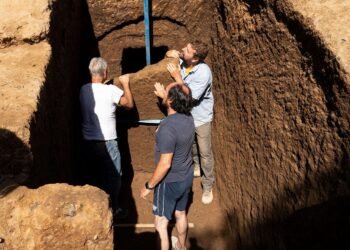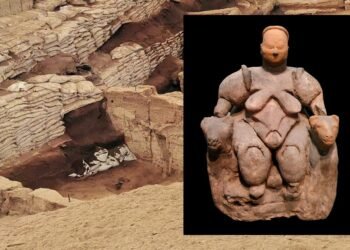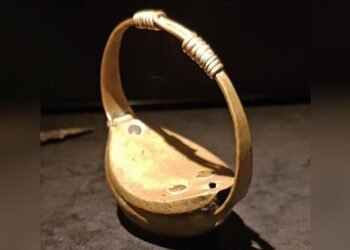Archaeologists have unearthed potential Bronze Age remains at the SaxaVord Spaceport construction site on the Lamba Ness peninsula in Unst, Shetland.

The findings include several deposits of burnt bone, believed to be associated with cremation deposits. Notably, a quartz setting was also uncovered, which holds importance in prehistory and is often linked to burial tombs and rock art panels. The research suggests that the remains found could date back to 2200-1800 BCE.
Katie O’Connell from AOC Archaeology, which assessed the site, emphasized the significance of the discoveries, suggesting that the location could have been a cremation cemetery in continuous use over time. She noted the presence of pits, large boulders, and bone deposits, indicating repeated use of the site. Dr. Val Turner, Shetland’s regional archaeologist, expressed excitement at the potential confirmation of Bronze Age cremation cemeteries, an era about which less is known compared to other periods in Shetland’s history.
Despite the archaeological findings, the construction of the SaxaVord Spaceport will continue as planned. Frank Strang, the spaceport’s CEO, acknowledged the importance of the discovery, which expands the site’s known history to over 4,000 years, ranging from the Bronze Age to the Space Age. SaxaVord Spaceport aims to serve as a ground station and rocket launch site for small rockets to access low earth orbit.
The SaxaVord Spaceport site is located on Unst, Shetland, and is poised to become Europe’s premier rocket launch site. Excavation and analysis of the archaeological remains are still in the early stages, but the findings present a unique opportunity for researchers to gain insight into the prehistoric inhabitants of Shetland. The spaceport’s launch preparations, including the installation of a 12-meter-high rocket launch stool and construction of hangars and launch pads, will continue.
The discovery has sparked enthusiasm among archaeologists, as they explore the potential links between large stones, pits, the quartz setting, and the cremation cemetery, proposing the possibility of a ritual complex. SaxaVord Spaceport and researchers are eager to conduct further studies to unravel the full story behind these ancient remains.
SaxaVord Spaceport’s establishment signifies an exciting venture for the UK’s space industry, as it plans to launch rockets carrying small satellites into space. With the planned first lift-off scheduled for later this year by German company HyImpulse and another orbital satellite launch in 2024 by Rocket Factory Augsburg, the spaceport aims to contribute to satellite operations and further space exploration.
The discovery of potential Bronze Age remains at SaxaVord Spaceport adds to the remarkable accessibility of Bronze Age Britain for archaeologists, as it allows them to explore and preserve significant sites. Other discoveries, like the well-preserved Bronze Age settlement of Must Farm and the identification of the earliest cases of the plague in Britain in the Bronze Age remains, continue to shed light on this ancient era.
























